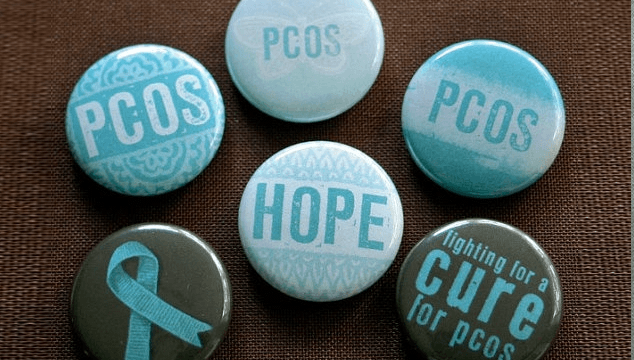PCOS (Polycystic ovarian syndrome)
- font size decrease font size increase font size
 Polycystic Ovary Syndrome affects an estimated 5-10 percent of women of childbearing age and it is a leading cause of infertility(due to infrequent or lack of ovulation). It is the most common hormonal disorder among women of reproductive age.
Polycystic Ovary Syndrome affects an estimated 5-10 percent of women of childbearing age and it is a leading cause of infertility(due to infrequent or lack of ovulation). It is the most common hormonal disorder among women of reproductive age.
PCOS is generally considered a syndrome rather than a disease. The name of the condition comes from the appearance of the ovaries in most, but not all, women with the disorder — enlarged and containing numerous small cysts located along the outer edge of each ovary (polycystic appearance). Other names for Polycystic Ovary Syndrome are Stein-Leventhal Syndrome, hyperandrogenic chronic anovulation, functional ovarian hyperandrogenism, and Polycystic Ovary Disease.
The exact cause of polycystic ovary syndrome is unknown. However a number of studies have linked PCOS development and progession to, elevated insulin levels, valproate- a medication used to treat seizures, hereditary predisposition, obesity.
Symptoms
Polycystic ovary syndrome signs and symptoms often begin soon after you first begin having periods (menarche). In some cases, PCOS develops later on during your reproductive years, for instance, in response to substantial weight gain.
Signs and symptoms vary from person to person, in both type and severity. They may be:
Amenorrhea (no menstrual period), infrequent menses, and/or oligomenorrhea (irregular bleeding) — Cycles are often greater than six weeks in length, with eight or fewer periods in a year. Irregular bleeding may include lengthy bleeding episodes, scant or heavy periods, or frequent spotting.
- Oligo or anovulation (infrequent or absent ovulation) — While women with PCOS produce follicles — which are fluid-filled sacs on the ovary that contain an egg — the follicles often do not mature and release as needed for ovulation. It is these immature follicles that create the cysts.
- Hyperandrogenism — Increased serum levels of male hormones. Specifically, testosterone, androstenedione, and dehydroepiandrosterone sulfate (DHEAS).
- Infertility — Infertility is the inability to get pregnant within six to 12 months of unprotected intercourse, depending on age. With PCOS, infertility is usually due to ovulatory dysfunction.
- Cystic ovaries — Classic PCOS ovaries have a "string of pearls" or "pearl necklace" appearance with many cysts (fluid-filled sacs). It is difficult to diagnose PCOS without the presence of some cysts or ovarian enlargement, but sometimes more subtle alterations may not have been recorded, or are not recognized as abnormal, by the ultrasonographer.
- Enlarged ovaries — Polycystic ovaries are usually 1.5 to 3 times larger than normal.
- Chronic pelvic pain — The exact cause of this pain isn't known, but it may be due to enlarged ovaries leading to pelvic crowding. It is considered chronic when it has been noted for greater than six months.
- Obesity or weight gain — Commonly a woman with PCOS will have what is called an apple figure where excess weight is concentrated heavily in the abdomen, similar to the way men often gain weight, with comparatively narrower arms and legs. The hip:waist ratio is smaller than on a pear-shaped woman — meaning there is less difference between hip and waist measurements. It should be noted that most, but not all, women with PCOS are overweight.
- Insulin resistance, hyperinsulinemia, and diabetes — Insulin resistance is a condition where the body's use of insulin is inefficient. It is usually accompanied by compensatory hyperinsulinemia — an over-production of insulin. Both conditions often occur with normal glucose levels, and may be a precursor to diabetes, in which glucose intolerance is further decreased and blood glucose levels may also be elevated.
- Dyslipidemia (lipid abnormalities) — Some women with PCOS have elevated LDL and reduced HDL cholesterol levels, as well as high triglycerides.
- Hypertension (high blood pressure) — Blood pressure readings over 140/90.
- Hirsutism (excess hair) — Excess hair growth such as on the face, chest, abdomen, thumbs, or toes.
- Alopecia (male-pattern baldness or thinning hair) — The balding is more common on the top of the head than at the temples.
- Acne/Oily Skin/Seborrhea — Oil production is stimulated by overproduction of androgens. Seborrhea is dandruff — flaking skin on the scalp caused by excess oil.
- Acanthosis nigricans (dark patches of skin, tan to dark brown/black) — Most commonly on the back of the neck, but also but also in skin creases under arms, breasts, and between thighs, occasionally on the hands, elbows and knees. The darkened skin is usually velvety or rough to the touch.
- Acrochordons (skin tags) — Tiny flaps (tags) of skin that usually cause no symptoms unless irritated by rubbing.
Diagnosis
Much of the bloodwork that should be done in diagnosing or ruling out PCOS is the same as a basic fertility workup; however, there are a couple of additional tests for insulin resistance that should be added, as well as some cholesterol screening to evaluate general health status because of the future risks associated with PCOS. The diagnosis of PCOS also requires the exclusion of all other disorders that can result in menstrual irregularity and hyperandrogenism. Biochemical and/or imaging studies must be done to rule out these other possible disorders and ascertain the diagnosis.
Different criterias have been formulated in diagnosing PCOS.
- A 1990 expert conference sponsored by National Institute of Child Health and Human Disease (NICHD) of the United States National Institutes of Health (NIH) proposed the following criteria for the diagnosis of PCOS:
- Oligo-ovulation or anovulation manifested by oligomenorrhea or amenorrhea
- Hyperandrogenism (clinical evidence of androgen excess) or hyperandrogenemia (biochemical evidence of androgen excess)
- Exclusion of other disorders that can result in menstrual irregularity and hyperandrogenism
- The European Society for Human Reproduction and Embryology (ESHRE) and the American Society for Reproductive Medicine (ASRM) recommended that at least 2 of the following 3 features are required for PCOS to be diagnosed15 :
- Oligo-ovulation or anovulation manifested as oligomenorrhea or amenorrhea
- Hyperandrogenism (clinical evidence of androgen excess) or hyperandrogenemia (biochemical evidence of androgen excess)
- Polycystic ovaries (as defined on ultrasonography)
- Polycystic ovaries are defined as 12 or more follicles in at least 1 ovary measuring 2-9 mm in diameter or a total ovarian volume of >10 cm3.
Test included are:
- measuring total and free testosterone levels or a free androgen index.
- Levels of sex hormone–binding globulin (SHBG)
- serum hCG level
- serum 17-hydroxyprogesterone levels after a cosyntropin stimulation test
- urine sample for free cortisol and creatinine.
- fasting serum prolactin concentration
- oral glucose-tolerance test
- The fasting lipid profile
- The thyroid-stimulating hormone (TSH)
- serum IGF-1 level
- Ovarian ultrasonography
Treatment
PCOS is a condition that is managed, rather than cured. Medical management is aimed at the treatment of metabolic derangements, anovulation, hirsutism, and menstrual irregularity.
Metabolic derangements
- Diet and exercise: In patients with PCOS who are obese, endocrine-metabolic parameters markedly improve after 4-12 weeks of dietary restriction.
- Metformin: This antidiabetic drug improves insulin resistance and decreases hyperinsulinemia in patients with PCOS.Metformin also has a small but beneficial effect on metabolic syndrome.
Anovulation
- Evidence suggests that metformin frequently—but not universally—improves ovulation rates in women with PCOS.In addition, pretreatment with metformin has been shown to enhance the efficacy of clomiphene for inducing ovulationN-acetylcysteine may also enhance the effect of clomiphene.
Hirsutism
- Hair removal: shaving and use of chemical depilatories and/or bleaching cream, electrolysis and laser treatment (Plucking or waxing unwanted hair can result in folliculitis and ingrown hairs.)
- Weight reduction: Weight reduction decreases androgen, therefore, losing weight can slow hair growth. Oral contraception: Women who do not wish to become pregnant can be effectively treated for hirsutism with oral contraceptives.Oral contraceptives slow hair growth in 60-100% of women with hyperandrogenemia. Therapy can be started with a preparation that has a low dose of estrogen and a nonandrogenic progestin. Preparations that have norgestrel and levonorgestrel should be avoided because of their androgenic activity.
- Spironolactone: Antiandrogens, such as spironolactone, are effective for hirsutism.27 Spironolactone 50-100 mg twice daily is an effective primary therapy for hirsutism.
- Eflornithine: Eflornithine (Vaniqa) is a topical cream that can be used to slow hair growth. Eflornithine works by inhibiting ornithine decarboxylase, which is essential for the rapidly dividing cells of hair follicles.
Menstrual irregularity
- This is treated with an oral contraceptive, which not only inhibits ovarian androgen production but also increases SHBG production.
- Pregnancy should be excluded before therapy with oral contraceptives is started.
Surgical Care
Surgical management is aimed mainly at restoring ovulation.
- Ovarian wedge resection: This procedure has fallen out of favor because of postoperative adhesion formation and the introduction of ovulation-inducing medications.
- Laparoscopic surgery: Various laparoscopic methods, including electrocautery, laser drilling, and multiple biopsy, have been used with the goal of creating focal areas of damage in the ovarian cortex and stroma. Potential complications include formation of adhesions (although this is less common than with traditional surgical approaches) and ovarian atrophy. Multiple pregnancy rates are lower with ovarian drilling than with gonadotrophin treatment (1% versus 16%), but there are ongoing concerns about the long-term effects on ovarian function.28
Diet
- PCOS patients who have impaired glucose tolerance should start a comprehensive program of diet and exercise to reduce their risk of developing diabetes mellitus.
- Obese women with PCOS can benefit from a low-calorie diet for weight reduction.
- A diet patterned after the type 2 diabetes diet has been recommended for PCOS patients.This diet emphasizes increased fiber; decreased refined carbohydrates, trans fats, and saturated fats; and increased omega-3 and omega-9 fatty acids. Omega-3 fatty acid supplementation has been shown to reduce liver fat content and other cardiovascular risk factors in women with PCOS, including those with hepatic steatosis, although these effects have not yet been proven to translate into a reduction in cardiometabolic events.30
Complications
Early diagnosis and treatment of polycystic ovary syndrome can help reduce the risk of long-term complications, such as type 2 diabetes, heart disease and stroke.
